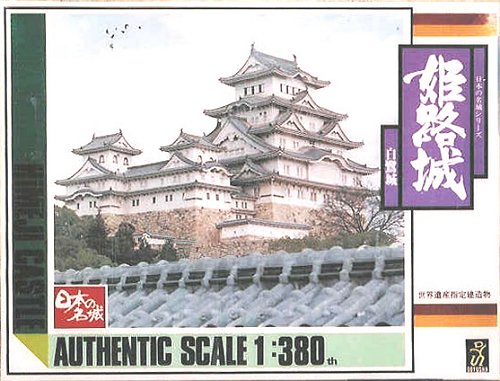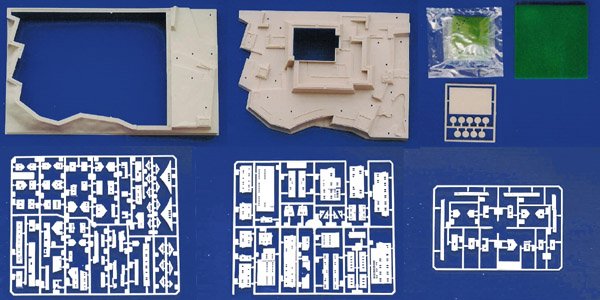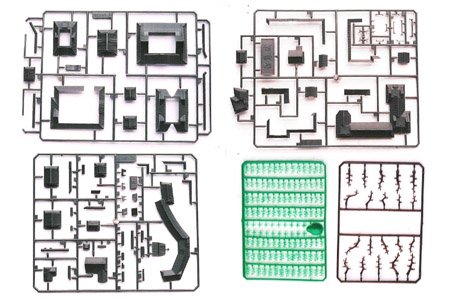
|
KIT: |
Doyusha 1/380 Himeji Castle |
|
KIT # |
DXC 2 |
|
PRICE: |
3,500 yen |
|
DECALS: |
none |
|
REVIEWERS: |
|
|
NOTES: |

|
HISTORY |
Himeji Castle (Himeji jo) is one of the last great castles to be built in Japan, and is considered the most impressive of the authentic surviving fortified castles. The town of Himeji, located approximately 50 kilometres West of Osaka, was considered the vital point of defence of the western part of Japan in the Seventeenth Century. It was decided to expand the small castle complex, built in 1346, into a strong defensive fortification. Construction of the Himeji Castle took place between 1601 and 1609, and has remained virtually unchanged since its completion. In 1931 it was designated a national treasure, and the castle was partially reconstructed and renovated in the 1960s. During this process great pains were taken to use only traditional construction methods, so Himeji Castle remains almost completely authentic.
Himeji Castle was built primarily as a defensive military structure and centre of political power. However, care was also taken that the castle displays the feudal lord's influence, power and wealth. One of the most striking features of Himeji Castle is its white walls, responsible for its name "Shirasagijo" or "White Heron Castle". White plaster was used to cover the wooden walls, not just for beauty but for fortification and also as a fireproofing measure. Himeji Castle is built on a foundation of stones, which were just piled up rather than being held together with mortar. This technique was employed to keep the foundation flexible in case of earthquake, and is still used in modern Japanese architecture.
Himeji Castle was built on top of Himeyama hill, and used the surrounding geography to its military and structural advantage. The Himeji Castle complex is 140 metres by 125 metres and is 45.6 metres above sea level. The complex consists of one main tower and three smaller towers, numerous other smaller buildings which served as storehouses and residences and three moats, all contained within a fifteen-metre stone wall. The main tower, which forms the centre of the castle is 46.4 metres high, and stands 92 metres above sea level. The main tower has seven floors (two below-ground) and is strengthened by two massive wood columns that run from the stone foundation to the roof, 42 metres above.
The main tower of Himeji Castle is magnificently articulated in the tradition Japanese style, with tier upon tier of roofs and gables. But for all its beauty, the castle is a brilliantly ingenious fortification. The stone wall surrounding the castle is fifteen metres high, so high that it looms over one's head so that one cannot see the sky and making it impossible for an approaching enemy to view the castle directly from the base of the walls. The castle has three moats - inner, middle, and outer - which serve as three lines of defence to wear down the enemy's strength and reserves. Himeji Castle is also famous for its highly effective and complicated defensive design, which is just like a maze. The basic shape of the Castle is that of a spiral with the main complex located in the centre, which the remaining buildings surround and protect. The wandering passages of the castle are intended to confuse an enemy unfamiliar with the layout.
From a defensive viewpoint, a castle gate is often considered the weakest point and vulnerable to enemy attack, because once the gate is breached enemy troops can come and go. In order to combat this, Himeji Castle's 84 gates are heavily fortified by wood and stone as well as very small so as to make it difficult to move a great many men through at one time. Himeji Castle incorporates numerous other ingenious defensive capabilities. There are ishiotoshi - openings in the walls of the main complex for throwing stones and scalding water, and sama - holes from which rifles and arrows can be shot. There are also shinobi-gaeshi - sharp inlaid spikes at places where an enemy is likely to invade, and musha kakushi - warriors' hiding place behind the wall. Nowhere is the design of a fortified Japanese castle more ingeniously contrived than at the Himeji Castle.
Ironically, despite its military strength and significance, there has never been a battle at Himeji Castle. Throughout its history, Himeji Castle has served various purposes. In times of peace, it showed off its prestige and beauty and was used as a mansion for feudal lords as well as a warehouse for arms and provisions. In times of war, it has served as both an observatory and command tower. Because no battle has taken place at Himeji, the Castle has retained its present shape for almost 400 years and the whole structure including towers, stone ramparts, and earthen walls are extremely well preserved. Today, Himeji Castle is a premiere tourist destination in Japan, and in 1993 was registered on UNESCO's World Heritage list, because it is a wooden castle structure of incomparable worth in the world.
|
THE KIT |
This kit is one of a series of Japanese castles that Doyusha produces. All of the most famous and significant castles are represented in several scales. Himeji, for example, is available in 1/380, 1/500 and 1/800. A few of the kits (including this one) are also available chrome-plated. The range seems to have been around for a while – the copyright date on the instructions of this example is 1973.
 The kit is moulded in thick, hard
styrene in three colours – white for the walls, dark grey for the roofs, and
(appropriately!) stone for the stone base. No doubt the idea is to allow young
or inexperienced builders the option of achieving a colourful result without
having to paint the model, as with those old Matchbox kits we all remember so
fondly. Doyusha has also supplied two sprues of vinyl parts to make the trees in
the castle grounds – one brown for the trunks and one green for the leaves.
These look like they would assemble into decidedly surreal-looking trees, and
are perhaps best overlooked (or saved for some strange alien landscape, but
that’s another project…). Another green vinyl part apparently represents a
hillock for the grounds but why this is moulded in vinyl instead of as part of
the styrene base is unclear, at least for now. The final touches included are a
small packet of flocking and a square of green sponge which the instructions
show should be torn up and glued around the base to represent foliage. Included
amongst the styrene parts are a nameplate (in Japanese) and small discs
representing the mons (family emblems) of some of the clans important to
Himeji’s history. The real castle has a similar display – a stone carving of
these mons, a photo of which can be found on one of the sites referenced
below.
The kit is moulded in thick, hard
styrene in three colours – white for the walls, dark grey for the roofs, and
(appropriately!) stone for the stone base. No doubt the idea is to allow young
or inexperienced builders the option of achieving a colourful result without
having to paint the model, as with those old Matchbox kits we all remember so
fondly. Doyusha has also supplied two sprues of vinyl parts to make the trees in
the castle grounds – one brown for the trunks and one green for the leaves.
These look like they would assemble into decidedly surreal-looking trees, and
are perhaps best overlooked (or saved for some strange alien landscape, but
that’s another project…). Another green vinyl part apparently represents a
hillock for the grounds but why this is moulded in vinyl instead of as part of
the styrene base is unclear, at least for now. The final touches included are a
small packet of flocking and a square of green sponge which the instructions
show should be torn up and glued around the base to represent foliage. Included
amongst the styrene parts are a nameplate (in Japanese) and small discs
representing the mons (family emblems) of some of the clans important to
Himeji’s history. The real castle has a similar display – a stone carving of
these mons, a photo of which can be found on one of the sites referenced
below.
Given a kit that was engineered at least thirty years ago, it’s not surprising that the mouldings are not exactly Twenty-First Century state-of-the-art, but they’re not that bad, either. The few fine detail parts (roof ornaments) are a little simple, but are still very crisp, and there’s practically no flash anywhere on the sprues. Particularly pleasing is the fact that the dozens of tiny windows are so perfectly rendered – they would have been a real pain to clean up otherwise!
The downsides are few and relatively minor. The ishiotoshi are moulded as wedges on the surface of the walls, and therefore effectively double the thickness of the already thick plastic in places. Predictably, this means sink marks, but these are not particularly severe and are easily puttied over. There are also many heavy gates and ejector pin marks scattered around the sprues, but care has generally been taken to ensure that these occur on the insides of walls and in other places which will not be visible once the model is assembled. There are only two spots where these moulding features mar the actual external surface of parts – under the eaves of one of the castle’s many roofs. Again, though, once it’s all put together, it seems quite possible that these will not be visible due to their proximity to the base and other parts of the structure (well, not visible to anyone without a dental mirror anyway…)
|
CONCLUSIONS |
This kit doesn’t look like it will present too many real difficulties, though we haven’t attempted any test-fitting yet, so the actual fit remains a mystery. The hollow interior and many windows virtually scream out for lighting, which we are planning to include. The real challenge will probably be in creating realistic-looking foliage and grounds, and it is anticipated that war gaming and model railway techniques, tips, and products will be useful here.
http://www.columbia.edu/itc/ealac/V3613/himeji/tpage.htm
http://www.himeji-castle.gr.jp/index/English/
http://www.jgc.co.jp/waza/a5_himeji/castle01.htm
http://www3.tky.3web.ne.jp/~edjacob/himeji.htm
"Castle of the White Heron" Phillips, J (2002) in A Guide to the World's Greatest Buildings, Howells, T (ed.), pp.72-73, Fog City Press, San Francisco.
If you would like your product reviewed fairly and quickly by a site that has well over 175,000 visitors a month, please contact me or see other details in the Note to Contributors.